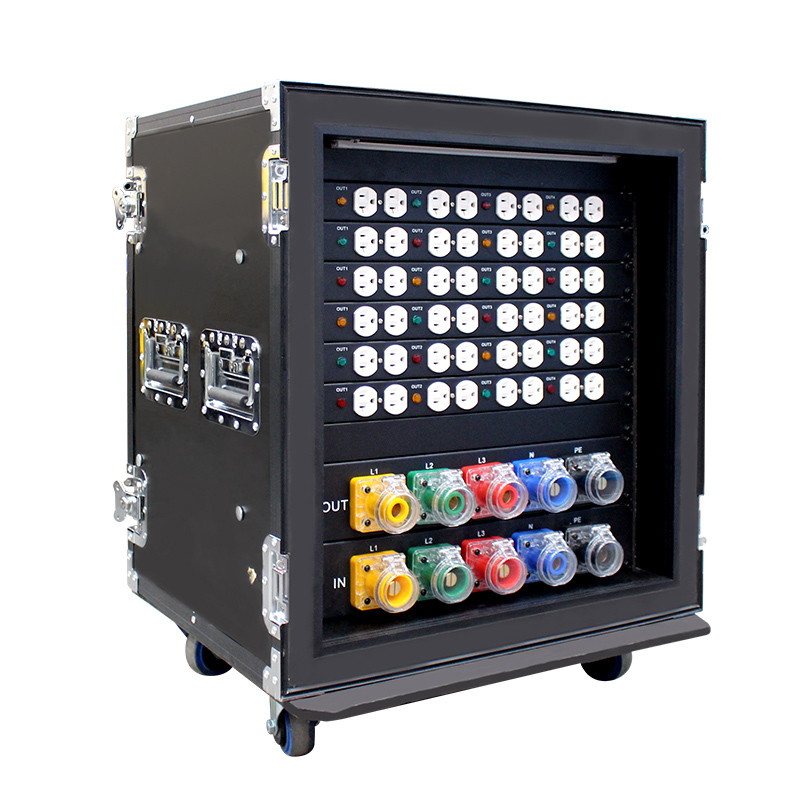In the current era of flourishing stage performance art, PHLTD’s stage lighting distribution boxes have emerged as the preferred choice for numerous performance venues and events due to their exceptional performance. They serve as the “power commanders” behind the scenes, precisely controlling every beam of light that illuminates the stage. Ensuring their stable and efficient operation is crucial for creating a flawless stage experience—a key factor in the success of any performance, much like the breathtaking fusion of lights and music at large-scale international music festivals. Without such equipment on stage, the entire production would be dull and unengaging, akin to actors performing without hearing the music, making their efforts less effective. Thus, the stage lighting distribution box is the most critical component behind the scenes of any stage production.
Over extended periods of operation, stage lighting distribution boxes inevitably encounter certain faults. A common issue is loose connections between 2p plugs (2-pole plugs) and 2p sockets (2-pole sockets), which can lead to poor contact and subsequent circuit failures. This is similar to the occasional contact issues that arise with aging electrical equipment in vintage-style bars abroad. In such cases, it is essential to carefully inspect the mating condition of the plugs and sockets. If any looseness or oxidation is detected, the oxide layer should be promptly cleaned, and the components should be re-tightened to ensure a secure connection. Additionally, similar issues may arise with 3-5 pin sockets (3-5 pin sockets) and 3 amp plug sockets (3-ampere plug sockets). During inspections, particular attention should be paid to ensuring good contact between the pins, much like the meticulous attention to detail that international tech enthusiasts devote to precision electronic devices.
For components related to 3 phase 16 amp (three-phase 16 amperes), such as 3 phase 16 amp plugs (three-phase 16-ampere plugs) and 3 phase 16 amp sockets (three-phase 16-ampere sockets), overheating is a common issue due to their high current-carrying capacity. This is somewhat analogous to the overheating that can occur in professional equipment used by international extreme sports enthusiasts under intense usage. Regular checks should be conducted to monitor their surface temperature. If excessive heat is detected, it may be caused by internal poor contact or overloading. Infrared thermal imaging cameras can be used for rapid detection and localization of hotspots, allowing for timely intervention. Simultaneously, the 3 phase 16a (three-phase 16-ampere) wiring should be inspected for damage or aging to prevent electrical leakage accidents, similar to the regular inspection and maintenance of automotive wiring systems in safety-conscious countries abroad.
For high-voltage components such as 3 phase 230v plugs (three-phase 230-volt plugs) and 3 phase 240v plugs (three-phase 240-volt plugs), insulation performance is of utmost importance. Insulation resistance should be regularly tested using insulation resistance testers to ensure it remains within safe limits. This is akin to the rigorous insulation performance testing conducted on precision instruments in high-end international laboratories. The connections of 3 phase 3 pin plugs (three-phase 3-pin plugs) and 3 phase 3 pin sockets (three-phase 3-pin sockets) must be secure to prevent sparking caused by looseness, much like the strict requirements for secure structural connections in international construction projects.
In terms of maintenance, in addition to regular inspections of the aforementioned components, special attention should be paid to the maintenance of 3 phase 32 amp sockets (three-phase 32-ampere sockets) and related 3 phase 32a (three-phase 32-ampere) components. Due to their higher current-carrying capacity, 3 phase 32a plugs (three-phase 32-ampere plugs) and 3 phase 32a sockets (three-phase 32-ampere sockets) have higher requirements for contact pressure and electrical conductivity. Conductive paste should be regularly applied to reduce contact resistance, similar to the lubrication maintenance performed on critical components in high-end international machinery.
For complex interfaces such as 3 phase 4 pin (three-phase 4-pin), 3 phase 4 pin sockets (three-phase 4-pin sockets), 3 phase 4 pin to 5 pin (three-phase 4-pin to 5-pin), 3 phase 5 pin 32 amp sockets (three-phase 5-pin 32-ampere sockets), 3 phase 5 pin 32a sockets (three-phase 5-pin 32-ampere sockets), 3 phase 5 pin industrial sockets (three-phase 5-pin industrial sockets), and 3 phase 5 pin to 4 pin (three-phase 5-pin to 4-pin), it is essential to check the reliability of the adapter connections to prevent signal transmission errors or unstable power supply due to conversion issues. This is akin to ensuring precise and error-free connections between high-tech products abroad to guarantee the normal operation of the entire system.
In terms of energy management and cost-effectiveness, selecting the appropriate configuration for the distribution box is crucial. Based on the actual requirements of the stage lighting, precise calculations of the required current and voltage should be made to avoid energy waste from over-provisioning. For example, in venues with lower lighting demands, appropriately sized 3 phase 16a or 3 phase 32a equipment can be chosen to avoid energy losses from using oversized equipment. This aligns with the environmentally conscious energy-saving principles advocated abroad, similar to how many households abroad reasonably use electrical appliances based on actual needs to reduce energy consumption. Additionally, regular cleaning and maintenance of the distribution box to ensure good heat dissipation can also effectively reduce energy consumption. Through proper energy management, not only can operational costs be reduced, but the lifespan of the distribution box can also be extended, thereby improving overall cost-effectiveness—a practice similar to the lifecycle cost management of equipment emphasized by international enterprises.
In summary, scientific fault diagnosis, effective maintenance, and reasonable energy management of PHLTD’s stage lighting distribution boxes can ensure their stable and efficient operation, delivering even more dazzling lighting effects on stage while achieving good cost-effectiveness. This approach resonates with the international pursuit of high-quality performances and efficient operations.
https://www.youtube.com/@%E7%8E%8B%E6%9C%8B%E6%9C%8B-i5b
https://www.facebook.com/pengpengwangPHLTD

